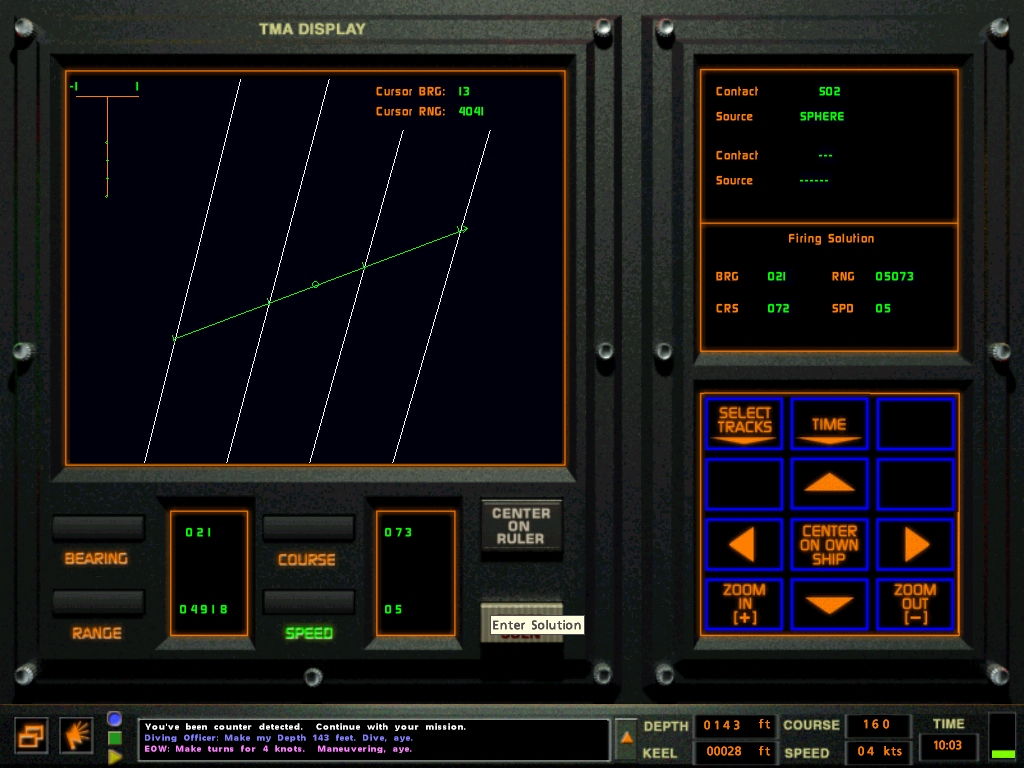
|
|
SUBSIM: The Web's #1 resource for all submarine & naval simulations since 1997
 |
SUBSIM: The Web's #1 resource for all submarine & naval simulations since 1997 |
 04-10-19, 09:02 AM
04-10-19, 09:02 AM
|
#1 |
|
Sailor man
 Join Date: Jan 2013
Location: Hong Kong
Posts: 50
Downloads: 78
Uploads: 3
|
This is my another open sourced project on automatic TMA. (code: https://github.com/LJQCN101/Auto-TMA-opencv)
Instructions on how to use is in the download page: (old version but with speed constraints)http://www.subsim.com/radioroom/down...o=file&id=5464 (new version with maneuvering target in mind) https://www.subsim.com/radioroom/dow...o=file&id=5605 This program is meant to assist your manual TMA process, as in real world sub does, in an external and mathematical way. It basically takes an image as input, like this image:  And it will perform cropping and line detection on the TMA display window. The program will ask you to hand-label all the detected lines numerically in chronological order, starting from 0. This will let the program know the time sequence of each bearing line. If the detected line appears not to be a bearing line, you can simply enter a negative number, such as -1, to exclude it from the TMA computation. (v0.3 update) You can also enter the speed of TMA ruler so the program can calculate proper speed of each solution. (v0.3 update) Speed constraint is added to only show solutions of specific speed. An example of output with speed constraint of 8.3 knots, if TMA ruler corresponds to 10 knots:  An example of output without speed constraint, if TMA ruler corresponds to 5 knots: Another example, taken from sub command tutorial:
__________________
Automatic TMA calculator (metric system) Automatic TMA line detector and solver for DW/SC/688i Automatic TMA line detector and solver for maneuvering target (new) Last edited by ljqcn101; 05-01-20 at 09:05 AM. |

|

|
 04-10-19, 09:07 AM
04-10-19, 09:07 AM
|
#2 |
|
Sailor man
 Join Date: Jan 2013
Location: Hong Kong
Posts: 50
Downloads: 78
Uploads: 3
|
For anyone who is interested in the formulas of automatic TMA:
First I set three unknown variables, 1. target distance at first bearing as "L1_distance" 2. target course as "crs" 3. target speed as "spd" Let ownship coordinate be (m,n). Y axis points to north (0 deg), and X axis points to east (90 deg). All angles start at Y axis and rotate in clockwise direction. So we can get: 1. target speed component on x axis "u" = spd * sin(crs) 2. target speed component on y axis "v" = spd * cos(crs) 3. target coordinate (a,b) at first bearing = m1+L1_distance*sin(brg1), n1+L1_distance*cos(brg1) 4. target coordinate (x,y) at time t = (a+u*t, b+v*t) 5. the vector pointing from ownship to target = (x-m, y-n) By knowing the bearing of this vector, we can get the bearing vector equation: (y-n)*sin(brg) = (x-m)*cos(brg) Since we have three unknown variables to solve, in order to make sure the left hand side of the equation is really close to the right hand side, we can use the least square method: Let formula f(t) = (y-n)*sin(brg) - (x-m)*cos(brg) So we need to minimise the sum of squared f(t) for all bearing vectors. I used BFGS algorithm to solve this utilising C++ Dlib library. |

|

|
 05-24-19, 01:39 AM
05-24-19, 01:39 AM
|
#3 |
|
Sailor man
 Join Date: Jan 2013
Location: Hong Kong
Posts: 50
Downloads: 78
Uploads: 3
|
Updated to v0.3 to include speed constraint. Check the examples in the original post.

|

|

|
 04-30-20, 04:12 AM
04-30-20, 04:12 AM
|
#4 | |
|
Sailor man
 Join Date: Jan 2013
Location: Hong Kong
Posts: 50
Downloads: 78
Uploads: 3
|
Hi, I decided to do some further research and implement a real-life method called 'Maneuvering Target Statistical Tracker (MTST)', which assumes that the target is maneuvering.
A simple history of this method: Quote:
|
|

|

|
 04-30-20, 04:55 PM
04-30-20, 04:55 PM
|
#5 |
|
ET2/SS
|
I had to know how a Kalman filter worked for one piece of Navy hardware and later for some systems I worked on as a field engineer for Kodak.  Just be careful. When the filter gets good data its no big deal. When it gets bad data, things go south very quickly.   This is very cool, just remember that TMA also has a Zen component and you need to be good at taking a guess every now and then. 
|

|

|
 05-01-20, 05:28 AM
05-01-20, 05:28 AM
|
#6 |
|
Sailor man
 Join Date: Jan 2013
Location: Hong Kong
Posts: 50
Downloads: 78
Uploads: 3
|
Yeah it does require an estimate regarding how much the target can change its course or speed.
I'm using most of its idea like IOU but didn't strictly following the paper though. Here's a preliminary result and I've uploaded for download, check my signature. |

|

|
 |
| Thread Tools | |
| Display Modes | |
|
|
